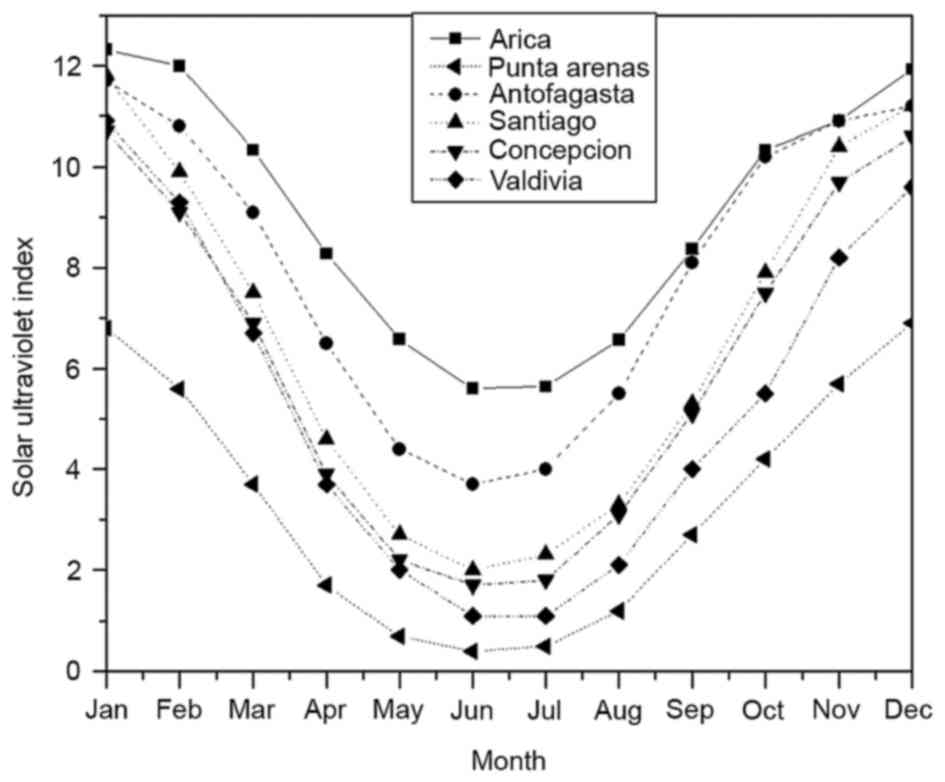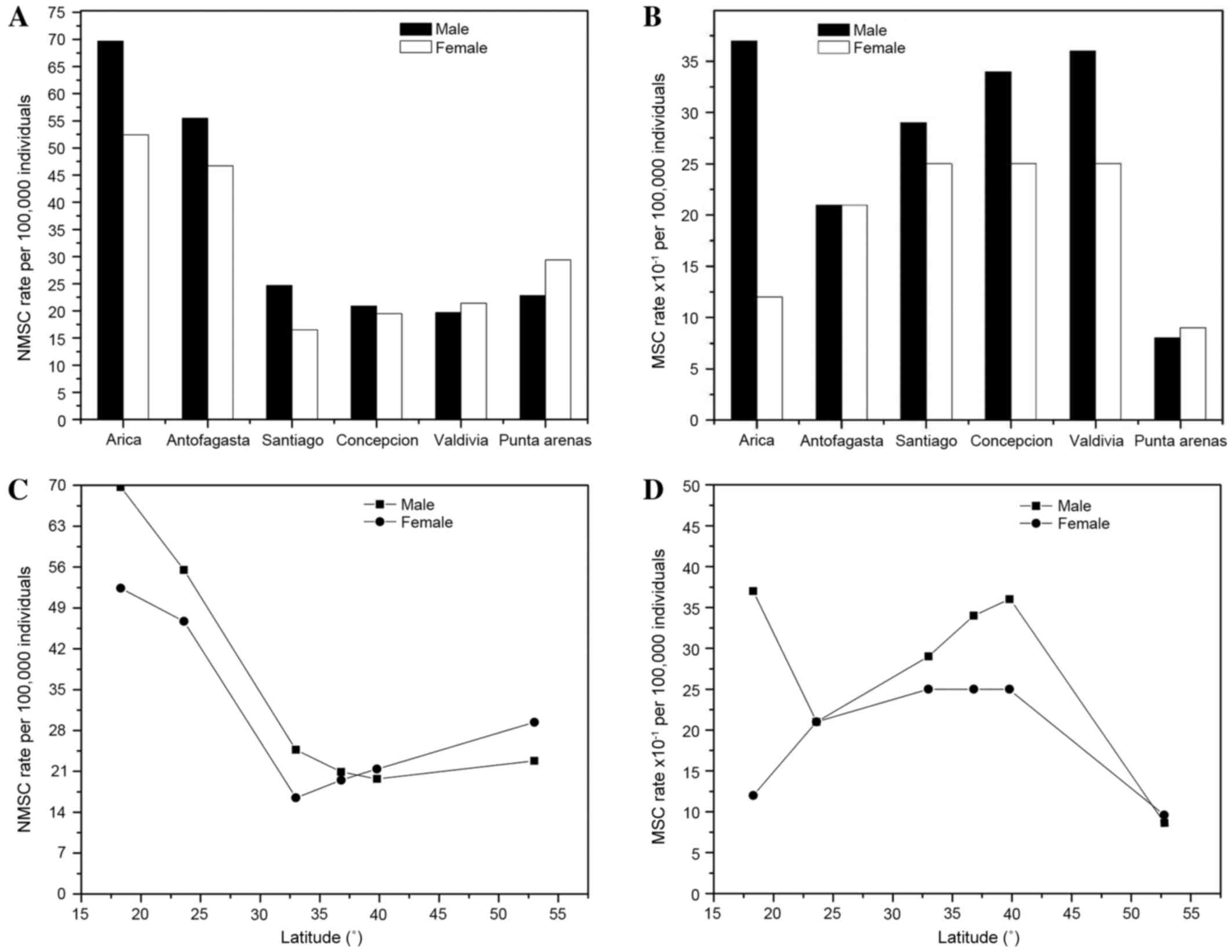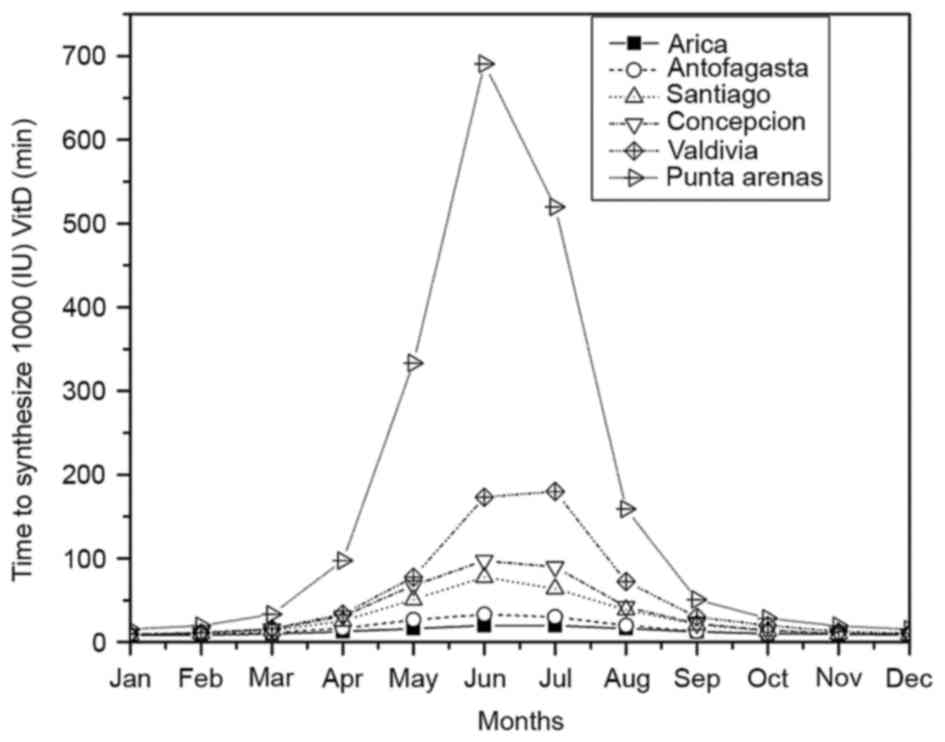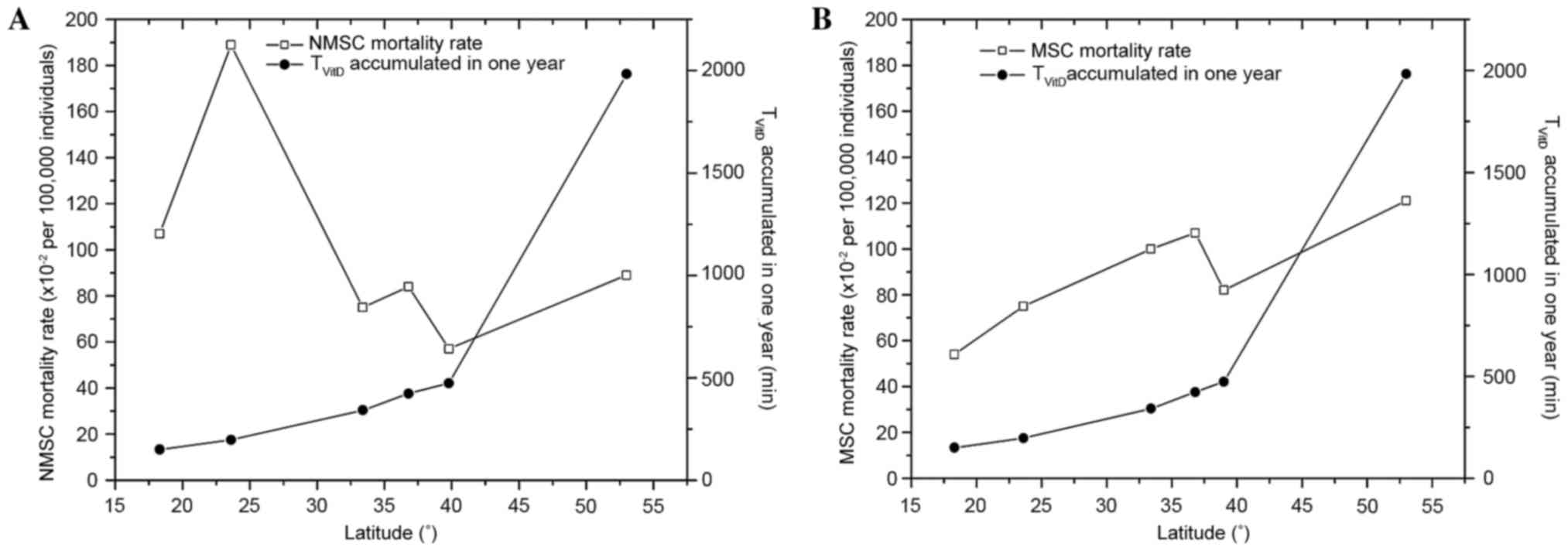|
1
|
Engelsen O: The relationship between
ultraviolet radiation exposure and vitamin D status. Nutrients.
2:482–495. 2010. View Article : Google Scholar : PubMed/NCBI
|
|
2
|
Holick MF: The use and interpretation of
assays for vitamin D and its metabolites. J Nutr. 120:(Suppl 11).
S1464–S1469. 1990.
|
|
3
|
Matsuoka LY, Wortsman J, Haddad JG, Kolm P
and Hollis BW: Racial pigmentation and the cutaneous synthesis of
vitamin D. Arch Dermatol. 127:536–538. 1991. View Article : Google Scholar : PubMed/NCBI
|
|
4
|
Porojnicu AC, Lagunova Z, Robsahm TE, Berg
JP, Dahlback A and Moan J: Changes in risk of death from breast
cancer with season and latitude: Sun exposure and breast cancer
survival in Norway. Breast Cancer Res Treat. 102:323–328. 2007.
View Article : Google Scholar : PubMed/NCBI
|
|
5
|
Matsuoka LY, Wortsman J, Dannenberg MJ,
Hollis BW, Lu Z and Holick MF: Clothing prevents ultraviolet-B
radiation-dependent photosynthesis of vitamin D3. J Clin Endocrinol
Metab. 75:1099–1103. 1992. View Article : Google Scholar : PubMed/NCBI
|
|
6
|
McKenna MJ: Differences in vitamin D
status between countries in young adults and the elderly. Am J Med.
93:69–77. 1992. View Article : Google Scholar : PubMed/NCBI
|
|
7
|
Edvardsen K, Brustad M, Engelsen O and
Aksnes L: The solar UV radiation level needed for cutaneous
production of vitamin D3 in the face. A study conducted among
subjects living at high latitude (68 degrees N). Photochem
Photobiol Sci. 6:57–62. 2007. View
Article : Google Scholar : PubMed/NCBI
|
|
8
|
Casado J, Parra P, Vega L and Suárez C:
Relación entre hormona paratiroidea y riesgo cardiovascular en
pacientes con insuficiencia de vitamina D. Med Clin. 141:292–294.
2013. View Article : Google Scholar
|
|
9
|
Miller DL and Weinstock MA: Non-melanoma
skin cancer in the United States: Incidence. J Am Acad Dermatol.
30:774–778. 1994. View Article : Google Scholar : PubMed/NCBI
|
|
10
|
Cannell JJ, Vieth R, Umhau JC, Holick MF,
Grant WB, Madronich S, Garland CF and Giovannucci E: Epidemic
influenza and vitamin D. Epidemiol Infect. 134:1129–1140. 2006.
View Article : Google Scholar : PubMed/NCBI
|
|
11
|
Lucena SR, Salazar N, Gracia-Cazaña T,
Zamarrón A, González S, Juarranz A and Gilaberte Y: Combined
treatments with photodynamic therapy for non-melanoma skin cancer.
Int J Mol Sci. 16:25912–25933. 2015. View Article : Google Scholar : PubMed/NCBI
|
|
12
|
Houghton AN and Polsky D: Focus on
melanoma. Cancer Cell. 2:275–278. 2002. View Article : Google Scholar : PubMed/NCBI
|
|
13
|
Donaldson MR and Coldiron BM: No end in
sight: The skin cancer epidemic continues. Semin Cutan Med Surg.
30:3–5. 2011. View Article : Google Scholar : PubMed/NCBI
|
|
14
|
Caini S, Gandini S, Sera F, Raimondi S,
Fargnoli MC, Boniol M and Amstrong BK: Meta-analysis of risk
factors for cutaneous melanoma according to anatomical site and
clinic-pathological variant. Eur J Cancer. 45:3054–3063. 2009.
View Article : Google Scholar : PubMed/NCBI
|
|
15
|
Caini S, Boniol M, Bazolli E, Tosti G,
Bazolli B, Russel-Edu W, Giusti F, Testori A and Gandini S: The
risk of developing a secondary primary cancer in melanoma patients:
A comprehensive review of the literature and meta-analysis. J
Dermatol Sci. 75:3–9. 2014. View Article : Google Scholar : PubMed/NCBI
|
|
16
|
Rivas M, Rojas E and Calaf GM: Prediction
of skin cancer occurrence by ultraviolet solar index. Oncol Lett.
3:893–896. 2012.PubMed/NCBI
|
|
17
|
Rivas M, Rojas E, Araya MC and Calaf GM:
Ultraviolet light exposure, skin cancer risk and vitamin D
production. Oncol Lett. 10:2259–2264. 2015.PubMed/NCBI
|
|
18
|
Rivas M, Araya MC, Durán V, Rojas E,
Cortes J and Calaf GM: Ultraviolet light exposure and skin cancer
in the city of Arica, Chile. Mol Med Rep. 2:567–572.
2009.PubMed/NCBI
|
|
19
|
Rivas M, Araya MC, Caba F, Rojas E and
Calaf GM: Ultraviolet light exposure influences skin cancer in
association with latitude. Oncol Rep. 25:1153–1159. 2011.PubMed/NCBI
|
|
20
|
Zemelman V, Alvarado O, Von Beck P and
Valenzuela C: Assessment of skin type, eye and hair color, freckles
tendency in Chilean adolescents. J Eur Acad Dermatol Venereol.
12:3211990.
|
|
21
|
Fitzpatrick TB: The validity and
practicality of sun-reactive skin types I through VI. Arch
Dermatol. 124:869–871. 1988. View Article : Google Scholar : PubMed/NCBI
|
|
22
|
Grant WB: An ecologic study of cancer
mortality rates in Spain with respect to indices of solar UVB
irradiance and smoking. Int J Cancer. 120:1123–1128. 2007.
View Article : Google Scholar : PubMed/NCBI
|
|
23
|
Grant WB: The effect of solar UVB doses
and vitamin D production, skin cancer action spectra, and smoking
in explaining links between skin cancers and solid tumours. Eur J
Cancer. 44:12–15. 2008. View Article : Google Scholar : PubMed/NCBI
|
|
24
|
Grigalavicius M, Moan J, Dahlback A and
Juzeniene A: Daily, seasonal, and latitudinal variations in solar
ultraviolet A and B radiation in relation to vitamin D production
and risk for skin cancer. Int J Dermatol. 55:e23–e28. 2016.
View Article : Google Scholar : PubMed/NCBI
|
|
25
|
Systems YES: Operation manual calibrated
high range YES-Biometer. Yankee Environmental Systems, Inc; Turners
Falls, OK, USA: 2006 http://www.yesinc.com/Accessed. September
5–2016
|
|
26
|
McKenzie RL, Liley JB and Björn LO: UV
radiation: Balancing risks and benefits. Photochem Photobiol.
85:88–98. 2009. View Article : Google Scholar : PubMed/NCBI
|
|
27
|
Holick MF: Biologic effects of light:
Historical and new perspectivesHolick MF and Jung EG: Biologic
effects of light 1998. Proceedings of a symposium Basel,
Switzerland November 1–3, 1998. Boston: Kluwer Academic Publishers;
pp. 11–32. 1999, View Article : Google Scholar
|
|
28
|
Vallebuono C: Primer informe de registros
poblacionales de cáncer de Chile, quinquenio 2003–2007, unidad de
vigilancia de enfermedades no transmisibles y estudios. Ministry of
Health of Chile. Epidemiology Section. 2012.
|
|
29
|
Giovannucci E, Liu Y, Rimm EB, Hollis BW,
Fuchs CS, Stampfer MJ and Willett WC: Prospective study of
predictors of vitamin D status and cancer incidence and mortality
in men. J Natl Cancer Inst. 98:451–459. 2006. View Article : Google Scholar : PubMed/NCBI
|
|
30
|
De Hertog SA, Wensveen CA, Bastiaens MT,
Kielich CJ, Berkhout MJ, Westendorp RG, Vermeer BJ and Bavinck
Bouwes JN: Leiden Skin Cancer Study: Relation between smoking and
skin cancer. J Clin Oncol. 19:231–238. 2001. View Article : Google Scholar : PubMed/NCBI
|
|
31
|
Milán T, Verkasalo PK, Kaprio J and
Koskenvuo M: Lifestyle differences in twin pairs discordant for
basal cell carcinoma of the skin. Br J Dermatol. 149:115–123. 2003.
View Article : Google Scholar : PubMed/NCBI
|
|
32
|
Garland FC, White MR, Garland CF, Shaw E
and Gorham ED: Occupational sunlight exposure and melanoma in the
U.S. Navy. Arch Environ Health. 45:261–267. 1990. View Article : Google Scholar : PubMed/NCBI
|
|
33
|
Moan J, Dahlback A and Setlow RB:
Epidemiological support for an hypothesis for melanoma induction
indicating a role for UVA radiation. Photochem Photobiol.
70:243–247. 1999. View Article : Google Scholar : PubMed/NCBI
|
|
34
|
Garland CF, Garland FC and Gorham ED:
Epidemiologic evidence for different roles of ultraviolet A and B
radiation in melanoma mortality rates. Ann Epidemiol. 13:395–404.
2003. View Article : Google Scholar : PubMed/NCBI
|
|
35
|
Millen AE, Tucker MA, Hartge P, Halpern A,
Elder DE, Guerry D VI, Holly EA, Sagebiel RW and Potischman N: Diet
and melanoma in a case-control study. Cancer Epidemiol Biomarkers
Prev. 13:1042–1051. 2004.PubMed/NCBI
|
|
36
|
Berwick M, Armstrong BK, Ben-Porat L, Fine
J, Kricker A, Eberle C and Barnhill R: Sun exposure and mortality
from melanoma. J Natl Cancer Inst. 97:195–199. 2005. View Article : Google Scholar : PubMed/NCBI
|
|
37
|
Gandini S, Sera F, Cattaruzza MS, Pasquini
P, Picconi O, Boyle P and Melchi CF: Meta-analysis of risk factors
for cutaneous melanoma: II. Sun exposure. Eur J Cancer. 41:45–60.
2005. View Article : Google Scholar : PubMed/NCBI
|
|
38
|
Republic of Croatia State Office for
Croats Abroad. 2013–2016. http://www.hrvatiizvanrh.hr/en/hmiu/croatian-diaspora-in-chile/22Accessed.
September 5–2016.
|
|
39
|
Urbach F: Incidence of nonmelanoma skin
cancer. Dermatol Clin. 9:751–755. 1991.PubMed/NCBI
|
|
40
|
Webb AR and Engelsen O: Calculated
ultraviolet exposure levels for a healthy vitamin D status.
Photochem Photobiol. 82:1697–1703. 2006. View Article : Google Scholar : PubMed/NCBI
|
|
41
|
Brenner M and Hearing VJ: The protective
role of melanin against UV damage in human skin. Photochem
Photobiol. 84:539–549. 2008. View Article : Google Scholar : PubMed/NCBI
|
|
42
|
Gandini S, Raimondi S, Gnagnarella P, Doré
JF, Maisonneuve P and Testori A: Vitamin D and skin cancer: A
meta-analysis. Eur J Cancer. 45:634–641. 2009. View Article : Google Scholar : PubMed/NCBI
|













